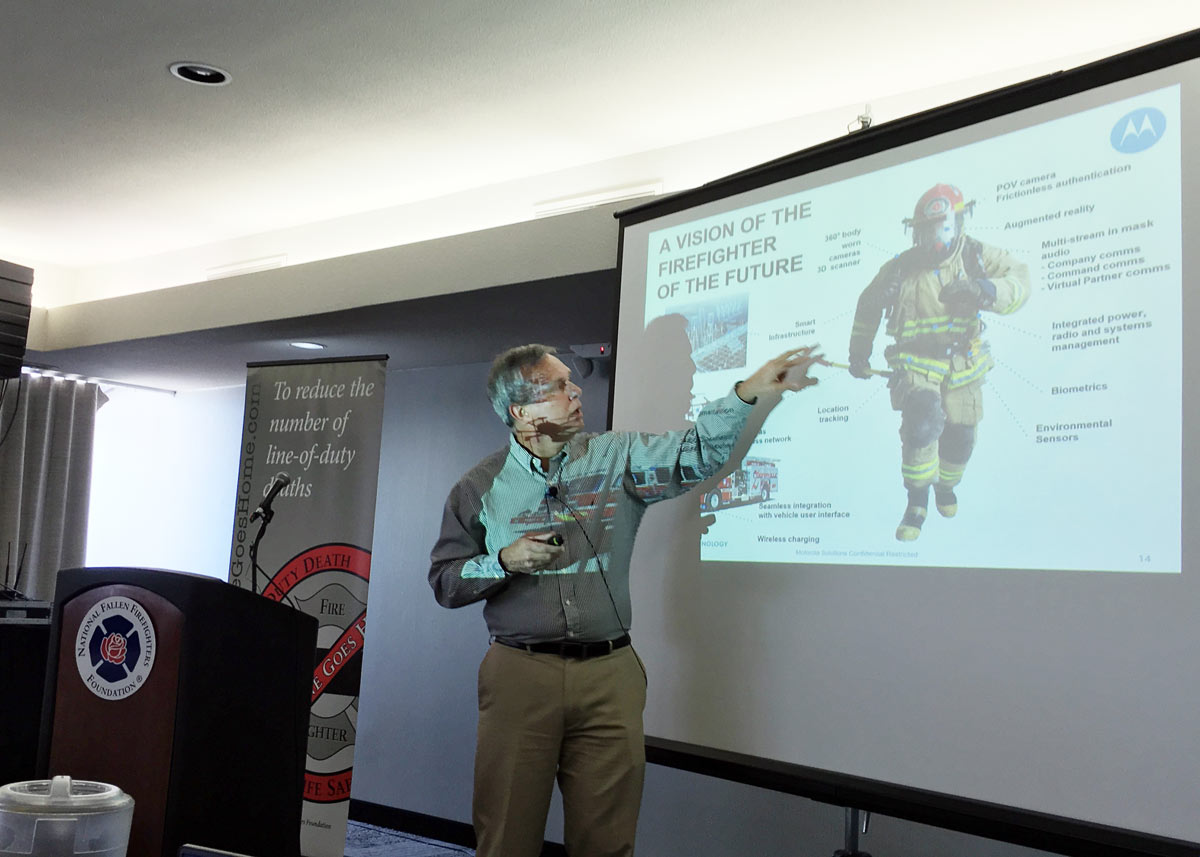
Technology is ubiquitous. Everything the public wants and needs to manage our daily lives is available and ready to use with the swipe of a finger. We access calendars, documents and movies on our phones and tablets. We track our workout schedules and fitness levels with a bracelet. Even our cars can lock our doors, adjust the seats and mirrors for individual drivers, or parallel park for us. Some can remind us that our most precious cargo is in the backseat.
As the world becomes increasingly technologically savvy, can the fire service also put these tools to use to improve safety and health? In July, the National Fallen Firefighters Foundation (NFFF) brought together 80 fire service officers, health and science researchers, and developers and manufacturers for the Fire Service Technology Summit to address this question.
From the Key Note Address by Casey C. Grant, P.E., of the Fire Protection Research Foundation at the National Fire Protection Association through several presentations and panel discussion, attendees realized much of the technology is already available. Personal fitness trackers, which were a novelty a few years ago, can be used to help create better SCBA or integrated in PPE to track heartrates and core temperatures of firefighters in an Immediately Dangerous to Life and Health (IDLH) situation. Chips and sensors in buildings can identify structural weaknesses and record fire behavior.
“We don’t need to reinvent anything,” Grant said. “We need to work with the developers who have the mechanisms in place to gather data.”
Collaborating and Communicating are Critical
“Researchers and developers should have access to many different types of departments and crews,” said Demond Simmons, Captain of Fire of the Oakland (CA) Fire Department and the South West Regional Director of the International Association of Black Professional Fire Fighters. He noted that developers often only go to the big urban departments to do their studies, when they need to also look at suburban and rural departments, as well as wildland crews.
Simmons also believes that the fire service needs to be more accepting in how research can help firefighters do their job more effectively. “It’s going to take us to engage the academic arena and say to them, ‘This is what we know, this is what we think we know and this is what we don’t know. How can you help us move forward in operational safety?’”
Lieutenant Lance Routson, of the Urbandale (IA) Fire Department, agreed that making connections with manufacturers is a critical step toward developing technology that will supplement a firefighter’s work and enhance efficiency.
“The industry representatives at the meeting said, ‘If you tell us what you want, we can make it.’ Until going to this meeting, I didn’t understand that.”
To get firefighters what they need requires collaboration to create viable prototypes. Specifically, it means providing details about the daily rigors and demands of the job. For example, a device that is designed to measure vitals must stay attached to a firefighter’s body while crawling across the floor of a building, pulling drywall and carrying hose or other heavy weights. The developer has to understand what the job entails to make an effective product.
“If something we design slows us down or distracts us from what we need to do on the fire ground, it won’t work,” Routson said. “Anything proposed or designed needs to be “eyes up and hands free.”
Why Do We Need New Technology Anyway?
Beyond establishing relationships with the researchers, developers and manufacturers is the question of convincing the fire service that technological advancements are a positive step. The majority of attendees believe it’s all in the presentation.
“The fire service is a very traditional organization. The presentation on how to implement new technologies will make the difference,” said Elizabeth Snow, Deputy Fire Chief of Wichita (KS). “The very young will eat technology up. The middle group will need proof before they buy in. Then the older firefighters will push back and still question the value. The presentation will make it easier to digest.”
Routson fully agrees. “Firefighters have to know ‘what’s in it for me’ at the early stages. They have to believe that what we’re doing is going to make our jobs easier and better,” he said.
For Chief Jack Rupp, of Plains Township (OH) Fire Department, the technology itself isn’t a new concept but a highly advanced concept. The potential for capturing data from sensors attached to firefighters in their gear, in the apparatus and in the structures could revolutionize the fire service.
“If we can merge all the technology around us – which is a tall order – it will not only enhance firefighter safety but improve outcomes for occupants in terms of injuries and structural damage,” Rupp said. “This potentially could have a positive impact on the entire community.”
Developing and adopting new technologies is not something that will occur quickly or easily. Change in the fire service tends to occur slowly.
“We hold onto our traditions very tightly,” said Rupp. He finds there’s often a concern that change is going to comprise an individual’s safety, the crew’s safety, and effectiveness with which they can do the job. But he and others are optimistic. “I think we’ll begin to see the fire service embrace technology simply because we’re already using it in our personal lives.”
The attendees also recognized that technology alone won’t make the fire service safer or firefighters healthier. Everyone still has to be accountable for their actions.
“You have to get exercise, you have to get sleep, you have to eat well,” said Routson. “We don’t need huge technological advances to make that more clear. This is still part of the discussion. Technology can help us make better decisions.”
Spreading the News
Although the number of attendees was limited, the enthusiasm and motivation for sharing what was discussed was impressive. They recognize they have an important role to play in sharing information if they want to keep the momentum growing.
“I realize it’s going to come down to strong leadership, senior administrators and company officers understanding the technology and being the conduit to disseminate the information to the boots on the ground,” said Routson.
Simmons agreed. “The fire service leaders will be responsible for moving it forward. I’m looking forward to the final report and I will take it to the other groups that I’m affiliated with to share information,” he said.
The final report from the Technology Summit is expected in fall of 2016.


